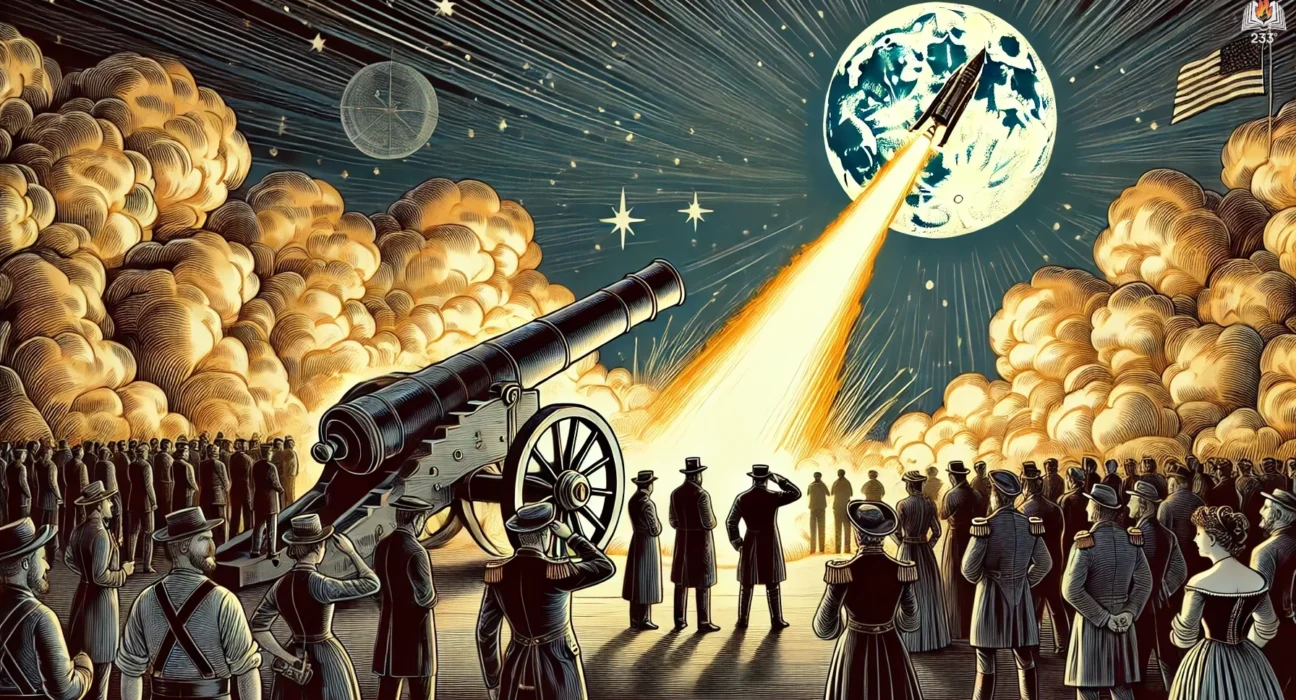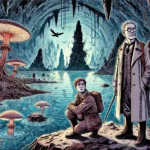“From the Earth to the Moon” is a classic science fiction novel by Jules Verne, first published in 1865. This story explores a daring post-Civil War venture by the members of the Baltimore Gun Club, who resolve to launch a manned projectile to the moon. It is one of Verne’s early works that combines technological imagination with visionary space exploration, reflecting the excitement and optimism of the scientific advancements of the 19th century.
Plot Summary
During a time of peace, in the bustling city of Baltimore, a group of men who had spent their lives perfecting the science of artillery found themselves aimless. The once-great Gun Club, famous for developing massive cannons during the American Civil War, was left with no wars to fight, no enemies to engage. But from the depths of this malaise rose a man with an idea so bold that it would change the course of their lives forever. His name was Impey Barbicane, the president of the Gun Club, and he intended to shoot a cannonball to the moon.
The project began in earnest with Barbicane’s announcement to the club. His plan was ambitious: to construct an enormous cannon capable of firing a projectile all the way to the moon. His idea electrified the club’s members, who, weary of their inactivity, embraced the concept with fervor. Across America, newspapers and scientists debated the feasibility of the plan, while excitement rippled through the country.
However, Barbicane’s vision faced opposition in the form of Captain Nicholl, a respected artillery expert and Barbicane’s long-time rival. Nicholl was skeptical, asserting that such an endeavor would fail due to the enormous speed and resistance needed to break free from Earth’s gravity. The tension between Barbicane and Nicholl simmered as both men made public wagers, with Nicholl claiming that the projectile would either explode on takeoff, fail to reach the necessary speed, or miss the moon entirely. Yet, despite the criticism, Barbicane pressed forward, convinced that the laws of physics and human ingenuity would prevail.
The Gun Club’s immediate task was to determine the best location to build the cannon. After much deliberation and scientific calculation, it was decided that the cannon, named the Columbiad, would be constructed in Florida, where the geographical latitude provided the best possible launch angle. With funding secured and support from citizens nationwide, work on the massive cannon began. The construction site became a place of spectacle, as thousands flocked to witness the building of the colossal instrument that would bridge the gap between Earth and its satellite.
In the midst of the preparations, a charismatic Frenchman named Michel Ardan arrived in the United States. Unlike anyone involved in the project so far, Ardan was not content with merely sending a cannonball to the moon; he proposed to travel inside the projectile himself. Ardan’s arrival brought new life to the project. His audacity and enthusiasm captured the imagination of the public, and even won over Captain Nicholl, who agreed to join the journey to the moon. With Barbicane, Nicholl, and Ardan all set to be passengers, the mission transformed from an experimental shot to a daring manned voyage.
The technical challenges of building a projectile that could carry human beings safely were immense. The Columbiad, an enormous cast-iron cannon, was prepared, and its projectile was modified to include a small, reinforced chamber that could house the three men and supply them with enough air, food, and water for the journey. The projectile was also designed with shock-absorbing mechanisms to protect the passengers from the immense force of the launch.
As the launch date approached, the entire world turned its eyes to Florida. Scientists, politicians, and curious onlookers gathered in anticipation of the moment when mankind would take its first step toward reaching the moon. With meticulous precision, the final preparations were made, and the projectile was loaded into the Columbiad. Barbicane, Nicholl, and Ardan took their places inside, knowing that success or failure would hinge on their ability to survive the incredible forces that awaited them.
At last, the moment arrived. On December 1st, at exactly the calculated time, the cannon was fired with an explosive force that shook the ground for miles around. The projectile, containing the three intrepid men, shot through the sky at an unimaginable speed, hurtling toward the moon. Cheers erupted from the crowd, though the fate of the passengers remained uncertain. For those on the ground, the only question was whether the daring adventurers would ever be heard from again.
Inside the projectile, the journey was perilous. The men endured violent shaking and the extreme G-forces of the launch. But once they escaped Earth’s atmosphere, the calmness of space enveloped them. They floated weightlessly, observing the moon growing ever larger in the viewport. During their journey, the three men marveled at the sight of the Earth shrinking behind them, a blue orb suspended in the vastness of space.
The travelers’ optimism, however, was tempered by moments of fear and uncertainty. Questions about their trajectory plagued them—would they land safely on the moon, or would they drift off into the void? As the projectile approached the moon, they calculated their position, realizing that their initial path was leading them toward a collision with the moon’s surface. Just as they braced for impact, a sudden realization dawned: their speed was too great for a controlled landing.
The projectile passed close to the moon, but rather than landing, it entered an orbit around the celestial body. They found themselves trapped in space, neither reaching the moon nor returning to Earth. Yet, in the face of this unexpected outcome, Barbicane, Nicholl, and Ardan were filled with awe. From their vantage point, they observed the moon’s barren, cratered surface in unprecedented detail. For the first time in human history, they had achieved the impossible: a journey from the Earth to the moon.
Back on Earth, the fate of the three astronauts remained a mystery. The world waited anxiously for news, but as days turned into weeks, hope began to wane. The daring venture had captured the imagination of an entire planet, but the outcome of their journey remained unknown, leaving their story suspended between triumph and tragedy.
Main Characters
- Impey Barbicane – The president of the Gun Club, Barbicane is a calm, determined leader with a scientific mind. He proposes the ambitious project of sending a cannonball to the moon and leads the effort with unwavering confidence in technology and human ingenuity.
- Captain Nicholl – An expert in armor and artillery, Nicholl is Barbicane’s rival, skeptical of the moonshot project. He represents doubt and caution, frequently challenging Barbicane’s optimism, especially regarding the practicality of the mission.
- Michel Ardan – A charismatic and adventurous Frenchman, Ardan is a last-minute addition to the project, proposing to make the journey himself in the projectile. His daring nature and imaginative ideas add energy and enthusiasm to the project, providing a counterbalance to Barbicane’s stoic rationalism.
- J.T. Maston – A devoted and slightly eccentric member of the Gun Club, Maston is a loyal supporter of Barbicane’s project. He is known for his enthusiasm and unyielding belief in the potential of artillery and science.
Theme
- The Power of Science and Human Ambition – Central to the novel is the idea that human ingenuity and scientific progress can overcome seemingly impossible challenges. The moonshot project symbolizes mankind’s relentless pursuit of knowledge and its belief in the power of technology to transcend natural boundaries.
- Rivalry and Collaboration – The tension between Barbicane and Nicholl highlights the conflict between ambition and skepticism, while Ardan’s arrival represents the power of collaboration and shared vision. This dynamic underscores the importance of teamwork in achieving great feats.
- The Frontier Spirit – Echoing the pioneering attitude of the time, the novel treats space exploration as the next great frontier, much like the American West. The characters embody the boldness and optimism of the 19th-century explorers who pushed the boundaries of human experience.
- Satire of Militarism and American Culture – Verne satirizes the American fascination with artillery and warfare through the overzealous members of the Gun Club. Their obsession with bigger, more powerful weapons is exaggerated, hinting at the absurdity of their militaristic enthusiasm in a time of peace.
Writing Style and Tone
Jules Verne’s writing in “From the Earth to the Moon” is marked by its blend of scientific precision and imaginative storytelling. Verne meticulously integrates real scientific knowledge with speculative ideas, crafting an atmosphere of excitement for technological progress. His descriptions of the Gun Club’s preparations and the technical details of the moonshot reflect his fascination with the possibilities of science. At the same time, he injects humor and satire, particularly in his portrayal of the Gun Club members and their eccentricities.
The tone is both optimistic and playful. Verne champions the ingenuity of human beings, often with a sense of awe at their capacity for innovation. However, he tempers this with a satirical edge, gently mocking the excesses of blind faith in technology and the absurdities of American gun culture. This balance between reverence for science and light-hearted critique gives the novel an engaging and thought-provoking quality.
We hope this summary has sparked your interest and would appreciate you following Celsius 233 on social media:
There’s a treasure trove of other fascinating book summaries waiting for you. Check out our collection of stories that inspire, thrill, and provoke thought, just like this one by checking out the Book Shelf or the Library
Remember, while our summaries capture the essence, they can never replace the full experience of reading the book. If this summary intrigued you, consider diving into the complete story – buy the book and immerse yourself in the author’s original work.
If you want to request a book summary, click here.
When Saurabh is not working/watching football/reading books/traveling, you can reach him via Twitter/X, LinkedIn, or Threads
Restart reading!








